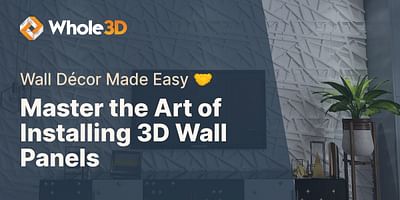Emory Schmidt is an accomplished architect with a keen interest in 3D design, particularly in the field of sustainable construction. Over the last 5 years, he has been part of the Whole 3D team, assisting clients in transforming their residential and commercial spaces with cutting-edge 3D wall panels and decor.
Yes, 3D printers can indeed be used for mass production, but it depends on the specific requirements and constraints of the production. The use of 3D printing for mass production is known as additive manufacturing, and it's revolutionizing industries by offering unprecedented levels of customization and flexibility.
Discover the Power of 3D Printing in Mass Production 🚀
The primary advantage of using 3D printing for mass production is the ability to produce complex and customized parts without the need for expensive tooling. This makes it possible to create personalized products on a large scale, something that was previously unattainable with traditional manufacturing methods.
Another benefit is the speed at which products can be brought to market. With 3D printing, it's possible to go from design to production in a fraction of the time it would take using conventional methods.
To better understand how 3D printing can be utilized for mass production, let's take a look at this video:
As you can see, large-scale 3D printing operations like the one showcased in the video can efficiently produce a high volume of customized parts, further emphasizing the benefits of 3D printing in mass production.
Unveiling the Challenges of 3D Printing for Mass Production 🧩
While 3D printing offers many advantages, there are also some limitations to consider when it comes to mass production. One of the main challenges is the speed of production. Although 3D printers have become faster and more efficient over the years, they still can't match the speed of traditional manufacturing methods for large-scale production runs.
Another limitation is the cost of materials. Although the price of 3D printing materials has been decreasing, they can still be more expensive than traditional manufacturing materials, especially for large-scale production.
Comparison of Material Costs for 3D Printing and Traditional Manufacturing
To give a clearer picture of the cost differences between 3D printing and traditional manufacturing, let's take a look at the following comparison table:
| Material | Cost of 3D Printing Material per kg ($) | Cost of Traditional Manufacturing Material per kg ($) |
|---|---|---|
| Plastic | 25-50 | 1-2 |
| Metal | 30-100 | 3-10 |
| Ceramic | 20-60 | 2-5 |
| Glass | Not commonly used | 0.5-2 |
| Wood | Not commonly used | 0.2-1 |
As seen from the table, while the cost of 3D printing materials has been decreasing, it can still be more expensive than traditional manufacturing materials for large-scale production.
Peeking into the Future: How 3D Printing Could Revolutionize Mass Production 🌐
Despite these challenges, the future of 3D printing in mass production looks bright. Advances in technology are continually improving the speed and reducing the cost of 3D printing, making it more feasible for mass production.
Furthermore, the ability to customize products and produce them quickly is becoming increasingly important in today's fast-paced, on-demand economy. As such, we can expect to see more and more industries turning to 3D printing for mass production in the future.
One of the leading companies in the 3D printing industry, Zeal 3D, has also expressed confidence in the future of 3D printing for mass production. They recently shared on their Twitter handle:















